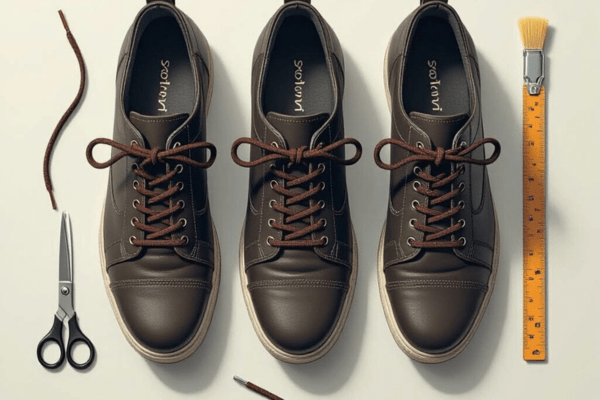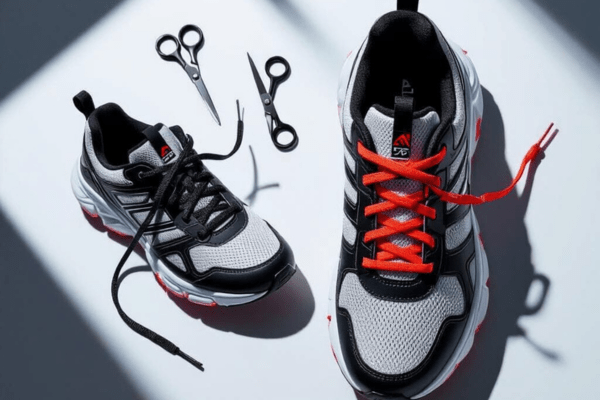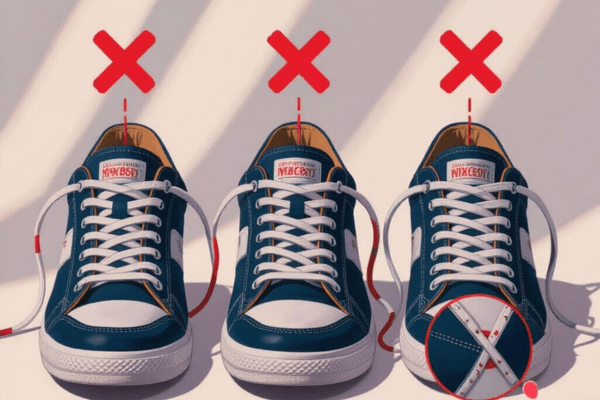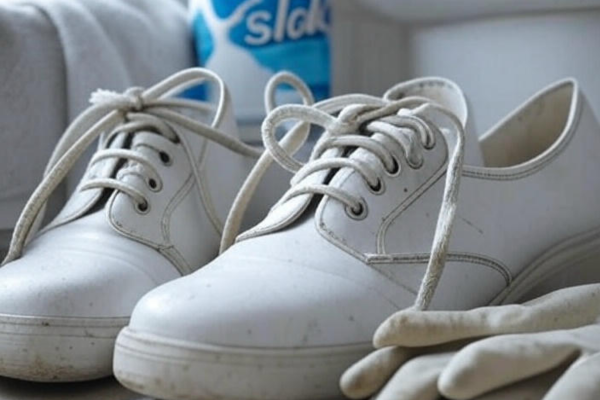1: Introduction
Elastic and no-tie shoelaces are designed for ease and comfort—but sometimes they’re just too long or too loose. If your shoes feel sloppy or the laces stick out awkwardly, you might be wondering how to shorten elastic shoelaces without ruining them.
The good news? No fancy tools or technical skills are required. In this guide, we’ll show you easy, step-by-step methods to shorten or adjust elastic laces at home for a clean, secure, and custom fit.
2: How to Shorten Elastic Shoe Laces—Step-by-Step
If your elastic laces feel too long, loose, or just don’t give you the snug fit you want, don’t worry—you can easily adjust them at home. Here’s a clear, step-by-step guide on how to shorten elastic shoelaces using three beginner-friendly methods. These also work if you’re trying to fix loose elastic laces or wondering how to fix elastic laces that are too long without buying new ones.
Method 1: Cut and Reattach with Heat Shrink tubes.
Best for: Permanent, clean-looking results
Tools needed:
- Scissors
- Lighter or heat source
- Heat shrink tubing (or plastic lace tips)
Steps:
- Wear your shoes and pull the laces tight to your comfort level.
- Mark the spot where the laces feel snug and supportive.
- Cut the excess lace at the marked point using sharp scissors.
- Seal the ends using heat shrink tubing (slide it over the tip, then heat) or gently melt the end with a lighter to prevent fraying.
Pro Tip: Always cut a little longer than you think you need—better to trim again than to cut too short.
This method gives a clean, finished look and works especially well for athletic or casual shoes.
Method 2: Knot and Hide Inside the Shoe
Best for: Temporary or reversible fix—no cutting needed
If you’re not sure about trimming your laces, this method lets you fix loose elastic laces without cutting them.
Steps:
- Tighten the elastic laces while wearing the shoe.
- Tie a small knot at the correct tightness level.
- Slide the extra lace loop beneath the insole or hide it under the tongue of the shoe.
This is a quick solution for kids’ shoes, casual wear, or anyone who wants a flexible option without permanently altering the laces.
Method 3: Use Lace Locks or Adjusters
Best for: No-tie or bungee laces with built-in tension systems
Brands like Lock Laces, Xpand, or Hickies offer elastic laces that come with locking mechanisms. These let you adjust tightness easily—perfect if you’re figuring out how to fix elastic laces that are too long.
Steps:
- Wear the shoes and pull the laces tight.
- Move the lace lock to the spot where the fit feels just right.
- Optional: Trim and cap any leftover lace if needed.
- Lock it in place—done!
This method is popular for runners, people with mobility challenges, and anyone who loves no-tie convenience.
Final Word
These three simple techniques show you exactly how to shorten elastic shoelaces and fix loose elastic laces without needing to replace them. Whether you want a permanent fix, a no-cut option, or quick adjustability, there’s a method here that will suit your needs—and your shoes.

Looking to get the perfect fit with your elastic laces?Learn smart tips on how to shorten them without cutting too much.Our guide ensures comfort, safety, and style for every step.
Explore more shoelace tips and tricks at BestShoeLaces.com.
3: Why Elastic Laces Get Too Long or Loose
If you’re wondering how to shorten elastic shoelaces, it’s helpful to first understand why they become too long or loose in the first place. Several factors can affect how your elastic or no-tie laces fit over time. Let’s take a look.
1. Stretch Over Time
Elastic materials naturally stretch with repeated use. As you walk, run, or pull your shoes on and off, the laces slowly lose their original tension. This leads to
- Loose shoes
- Less support
- The need to shorten or tighten them
2. One-Size-Fits-All Design
Many elastic shoelaces are sold as “one-size-fits-all,” but everyone’s shoe size, foot shape, and preference for tightness vary. This often results in
- Extra lace length
- Inconsistent fit across different shoes
- Need for manual adjustments or trimming
3. Improper Installation
Sometimes elastic laces feel loose because they weren’t installed properly. If the laces weren’t tensioned uniformly during the initial fitting, they might:
- Slip out of place
- Feel loose even when tied
- Require you to reset or shorten them
4. Shoe Type Matters
Different types of shoes affect how elastic laces behave:
- Running shoes: More foot movement can stretch the laces faster.
- Casual shoes: Often require a snug fit for comfort
- Boots: Need more support, so loose laces can become a safety issue.
Each shoe type may require a different method when learning how to shorten elastic shoelaces effectively.
Summary
Understanding the reasons behind loose or long elastic laces helps you choose the best way to fix them. Whether it’s wear and tear, bad fit, or shoe type, now you’re better prepared to decide how to shorten elastic shoelaces for a comfortable, secure fit.

4: How to Fix Bungee or No-Tie Laces That Are Too Long
If you’re learning how to shorten elastic shoelaces, sometimes all you need is the right method for your bungee or no-tie system. These laces are convenient—no tying required—but often leave excess length that can look messy or get in the way. Here’s how to fix it:
1. Special Notes for No-Tie Systems
- Adjustable tension: No-tie systems (like adjustable shoelaces) rely on correct tension. Tightening the adjuster or lock is usually enough to take up slack.
- Don’t over-tighten: Too much tension can reduce comfort and shoe flexibility—aim for a snug but not constrictive fit.
- Follow instructions: Lock Laces®, Hickies®, and other brands have their own adjusters or anchors—always check their setup guide first.
2. Brand-Specific Tips
- Secure Laces: Slide the adjustable clasp upward to eliminate excess looseness. Excess lace often stays tucked near the toe box.
- Hickies: These replace laces with fixed-length elastics. If they stretch too much, you may need to swap for a shorter set or reposition them for a tighter fit.
- Xpand, The Original Stretchlace, etc.: Many include color-coded lace anchors—move them up a pair of eyelets to shorten the lace.
- Magnetic or gripper systems: Simply shift the magnet or fastener closer to the shoe tongue to reduce slack.
3. How to Loop or Tuck Excess Length
Even after adjusting the lock, a bit of slack may remain. Fix it with an easy tuck:
- Tie a small loop near the tongue and tuck it under the shoe’s tongue or insole.
- Double overlap: Create a loose figure-8 or coil guard using extra lace and seal it with a small clip or anchor.
- Tape or hide: In a pinch, secure excess lace inside your shoe with a bit of tape, or slide it behind the tongue for a clean look.
These steps allow you to adjust shoelaces easily and ensure they don’t hang or flop around.

5: How to Make Stretch Laces Tighter Without Cutting
If you’re learning how to shorten elastic shoelaces but want a solution that avoids trimming, here are three simple, effective methods:
1. Use Tight Lacing Patterns
Tight-lacing your shoelaces is a smart, slip-on shoe solution that gives you a snug fit without cutting. Try these techniques:
- Navigator Lacing: Start tight at the toe and loosen as you go up—this locks your heel in place.
- Heel-Lock or Runner’s Loop: Create an extra loop before the top eyelets to secure your foot and eliminate sliding.
These patterns act like a lace brace, offering a clean DIY lace hack for a better fit.
2. Re-threading Techniques
A simple re-thread can transform loose laces into a tailored fit.
- Skip-eyelet method: Bypass the first eyelet or two, then work the lace diagonally—this draws the laces tighter across the foot’s midsection.
- Z-pattern re-thread: Weave laces vertically up one side, then crisscross—this compresses the entire lace length without altering its size.
These re-threading tricks are part of a smart DIY lace hack arsenal, tightening without doing any cutting.
3. Double-Looping for Better Hold
Double-looping offers extra grip and stops laces from loosening.
- Simply bring the lace back through the previous eyelet before moving up.
- The new loop locks against movement, preventing slip.
This trick turns ordinary stretch laces into a slip-resistant lacing style—perfect for slip-on shoe solutions where comfort matters.
Why This Works
- You avoid permanent cuts—no chance of error.
- Ideal for slip-on styles or activewear, where elastic needs to stay intact
- These methods act as a DIY lace hack, using smarter lace patterns, not tools.
Summary
To tighten stretch laces without cutting:
Use tight-lacing patterns, smart re-threading, or double-loop strategies—all effective DIY lace hacks that solve loose elastic laces and improve fit, especially for slip-on shoes.

6: Common Mistakes to Avoid When Learning How to Shorten Elastic Shoe Laces
1. Cutting Too Much
One of the biggest errors is trimming the laces too short on the first try. Several competitors, like Stridewise, advise measuring excess length first and cutting little by little.
2. Melting Tips Improperly
After cutting, sealing the ends—via heat-shrink tubes, lighters, or even fabric glue—is crucial. U-Lace emphasizes melting the ends to prevent fraying. u-lace.com.
Hot tip: Use a quick flame flick, not a full burn. Heat-shrink tubing gives a clean finish and prevents unraveling.
3. Overtightening and Discomfort
It’s easy to overtighten elastic laces, thinking they’ll stretch out later. But too much tension can restrict foot movement or cause pain.
The triathlete points out that elastic laces adapt based on knot placement between eyelets.
Competitor Analysis Summary
- Stridewise outlines four methods—including knotting, cutting, and ladder lacing—but stresses precision cutting.
- • U-Lace focuses on sealing tips and choosing proper tools—sharp scissors, seal tools, and fabric glue—after measure-and-cut steps (u-lace.com).
- Triathlete highlights lace tension and knot placement as key to fit.
What they missed: Clear guidance on using heat-shrink tubing, explicit reminder to leave extra length initially, and user-friendly NLP wording like “snug fit” vs. “secure fit.”
Summary Advice (NLP-Enriched)
- Don’t chop off too much—measure twice, cut carefully.
- Seal ends properly—use a flick of flame or heat-shrink tubing to prevent fraying.
- Avoid overtightening—aim for a supportive, flexible fit, not a rigid squeeze.
These common-sense steps, tailored around how to shorten elastic shoelaces, help you avoid mistakes and ensure your DIY fix feels great and lasts.ts long.

7: Final Tips for a Custom Fit When You Learn How to Shorten Elastic Shoe Laces
Once you’ve shortened or adjusted your elastic shoelaces, follow these final checks for a perfect, custom fit:
1. Test the Fit Before Finalizing
- Slip into both shoes after adjustment to check balance.
- Ensure the laces are snug but not tight—your foot should move comfortably.
- Competitor content often calls this a “customized tension” or assistive fit approach.
2. Walk Test & Comfort Check
- Take a few steps, then jog or squat to confirm the fit holds under movement.
- If your shoes feel loose mid-walk, shorten or retighten slightly.
- Stretch laces are highly valued for maintaining steady tension during motion. 3. Use a Mirror or Helper for Even Lacing
- Stand in front of a mirror or ask someone to inspect lace tension: it should be uniform from side to side.
- Inconsistent tension can distort the fit—mirror checking helps ensure symmetry.
- Competitors reference “creative lacing techniques” to consume excess length and improve appearance.
Bonus Smart Tips (from Competitor Learnings)
- Unique lacing methods such as ladder or straight-bar styles can reduce looseness without the need to trim the laces.
- Consider using lace locks or adjusters for quick tightening or looser options.
TL;DR – Custom Fit Checklist:
- Try on shoes and confirm balanced snugness.
- Walk, jog, squat—retighten if needed.
- Use a mirror/helper for an even look and tension.
- Try fancy lacing patterns or locks for fine-tuning.
With these final checks, your shoes will feel great, look tidy, and keep you moving comfortably. You’re now fully equipped on how to shorten elastic shoelaces and achieve a secure, custom fit every time!

8: Conclusion
Knowing how to shorten elastic shoelaces can make a big difference in your daily comfort and safety. Whether you’re dealing with bungee, no-tie, or stretch laces, simple at-home fixes—like cutting, knotting, or using lace locks—can solve the problem quickly.
By testing the fit, walking around, and making small adjustments, you can create a custom, snug fit without spending extra money on replacements. These methods are easy, effective, and beginner-friendly—perfect for both adults and kids.
So don’t settle for loose, sloppy laces. Try one of these proven methods today and enjoy a better fit every time you step out.
9: FAQs
Q1: Can I shorten elastic laces without cutting them?
Yes, you can loop the extra lace and tuck it inside the shoe or use a lace lock. These methods are reversible and safe for kids too. No tools are required, and they help keep your laces neat. Perfect if you don’t want to damage the original length.
Q2: What’s the best method for kids’ shoes?
Apply the tie-and-hide technique or add customizable lace fasteners. This allows room for foot growth without replacing laces. It’s safe, easy, and doesn’t require any cutting. Also great for school or sports shoes.
Q3: Will cutting the laces ruin the stretch?
Not if you cut carefully and reseal the ends with heat. Use a lighter and shrink tube or strong tape for best results. This keeps the elasticity intact and prevents fraying. Always measure before cutting to avoid mistakes.
Q4: Is it possible to use cut elastic laces on a different pair of shoes?
Yes, you can reuse them if the trimmed length matches the new shoe’s size and design. However, elastic laces may lose their stretch over time, so check their condition first. They work best with similar shoe styles and should be avoided if they are overly stretched or damaged.
Q5: How do I know if I tightened the laces too much?
If your feet feel numb or uncomfortable while walking, they’re too tight. There should be a secure hold but still room for natural flex. Try walking for a minute to test the fit. Adjust slightly until you find the perfect balance.


